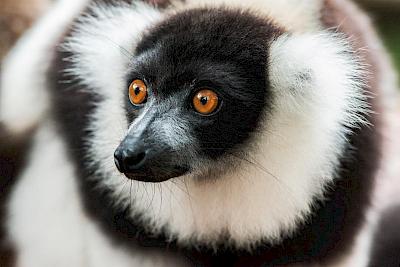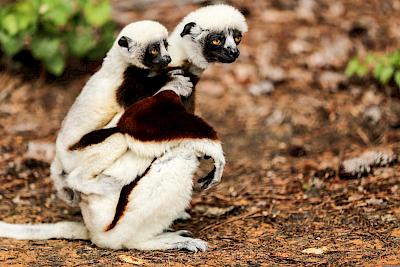
Transparency International & TRAFFIC
Banding together to protect lemurs: understanding and addressing their threats
Madagascar is home to an astonishing 113 species of lemurs – all of them endemic to the island, yet adored and popularised far beyond in zoos and blockbuster films. But we’re at great risk of losing these special animals unless laws are effectively upheld, and people, governments, and organisations come together on a strategy for their conservation. Read on to discover how Transparency International, TRAFFIC and other partners are responding to protect lemurs.

Lemurs come in all shapes and sizes. As seed dispersers and pollinators, they play a key role in creating and maintaining Madagascar’s unique forests. But with 98% of lemur species threatened with extinction and 31% Critically Endangered, the time to act is now. At least four species have been reduced to less than 500 individuals, and a further nine species to less than 10,000 individuals in the wild.
Arguably, the most significant factor underpinning historic losses for lemurs (in terms of both species diversity and overall numbers) has been habitat loss driven by deforestation, much of which is fuelling the illegal trade in precious hardwoods. All lemurs need intact forest ecosystems for their food. Nonetheless, direct poaching poses another concerning threat to wild lemur populations. In Madagascar, the vast majority of wildlife harvest is driven by a need for food, although many wild lemurs are also captured for the domestic pet trade.
In 2016, scientists estimated that the total number of captive lemurs held in Madagascar households between 2010 and mid-2013 amounted to a staggering 28,253 live individuals. In theory, the capture and trade in lemurs is prohibited both in Madagascar and internationally. All lemur species are listed on Appendix I of the Convention on International Trade in Endangered Species of Wild Fauna and Flora (CITES), affording them the highest level of protection against over-exploitation through international trade.
However, according to TRAFFIC’s court monitoring data (unpublished), more than 60 individual lemurs were seized by law enforcement between 2021 and 2023 in the two northern provinces of Madagascar alone (SAVA and DIANA). Most of these specimens were dead at the time of seizure and intended to be sold to local consumers as bushmeat. This is but a small sample of lemurs facing exploitation across the country.
Corruption is one of the main factors facilitating and exacerbating wildlife trafficking in Madagascar, as demonstrated by Transparency International – Initiative Madagascar. Investigations under the Countering Corruption and Wildlife Trafficking (CCWT) project revealed serious corruption risks in the illegal trade of Malagasy tortoises (including bribery, abuse of power and conflict of interest) during the harvest of wild specimens, court procedures, and during export. This project is funded by USAID and led by WWF, in collaboration with Transparency International, TRAFFIC and Alliance Voahary Gasy.

Madagascar currently lacks a nationwide government-sanctioned strategy for the conservation of lemurs, and has not adopted country action plans to protect the most at-risk, Critically Endangered lemur species. However, many of the country’s protected areas do have management plans and systems in place that include conservation targets for those lemur species occurring within the protected area.
In 2013, the IUCN Species Survival Commission Primate Specialist Group published a Madagascar Lemur Conservation Strategy in association with Conservation International and the Bristol Conservation and Science Foundation. If adopted, this would go a long way in protecting lemurs from the threats of both deforestation and poaching, whilst providing an alternative stream of income via ecotourism.
TRAFFIC is striving to safeguard Madagascar’s precious endemic wildlife through a variety of projects, including the LEMUR CWC (Law Enforcement in Madagascar: a United Response to Combating Wildlife Crime) project. Activities include assessing the country’s wildlife trade legislation and proposing amendments, connecting law enforcement agencies across borders, producing a Court Case Tracker tool so that authorities can analyse judicial data on wildlife crime cases, and providing training to law enforcement on detecting and combating illegal wildlife trade. Seizures of illegal wildlife including lemurs have been made as a direct result of these trainings, as reported by trainees.
Many other Malagasy conservation organisations and international partners are working together to raise awareness of lemur conservation within communities, ensure key lemur populations across crucial sites are secured, and empower relevant communities with skills and livelihood options to help them coexist with lemurs. Targeted habitat restoration initiatives and livelihood alternatives to bushmeat hunting can do a lot to protect the remaining wild lemur populations!
With so many individuals and organisations both on the ground and around the world fighting their corner, there’s still a lot of hope for lemurs if change happens now. For more examples of effective approaches, key project impacts, and inspiring stories, see the final report of the IUCN SOS Lemurs project (2017-2023).


